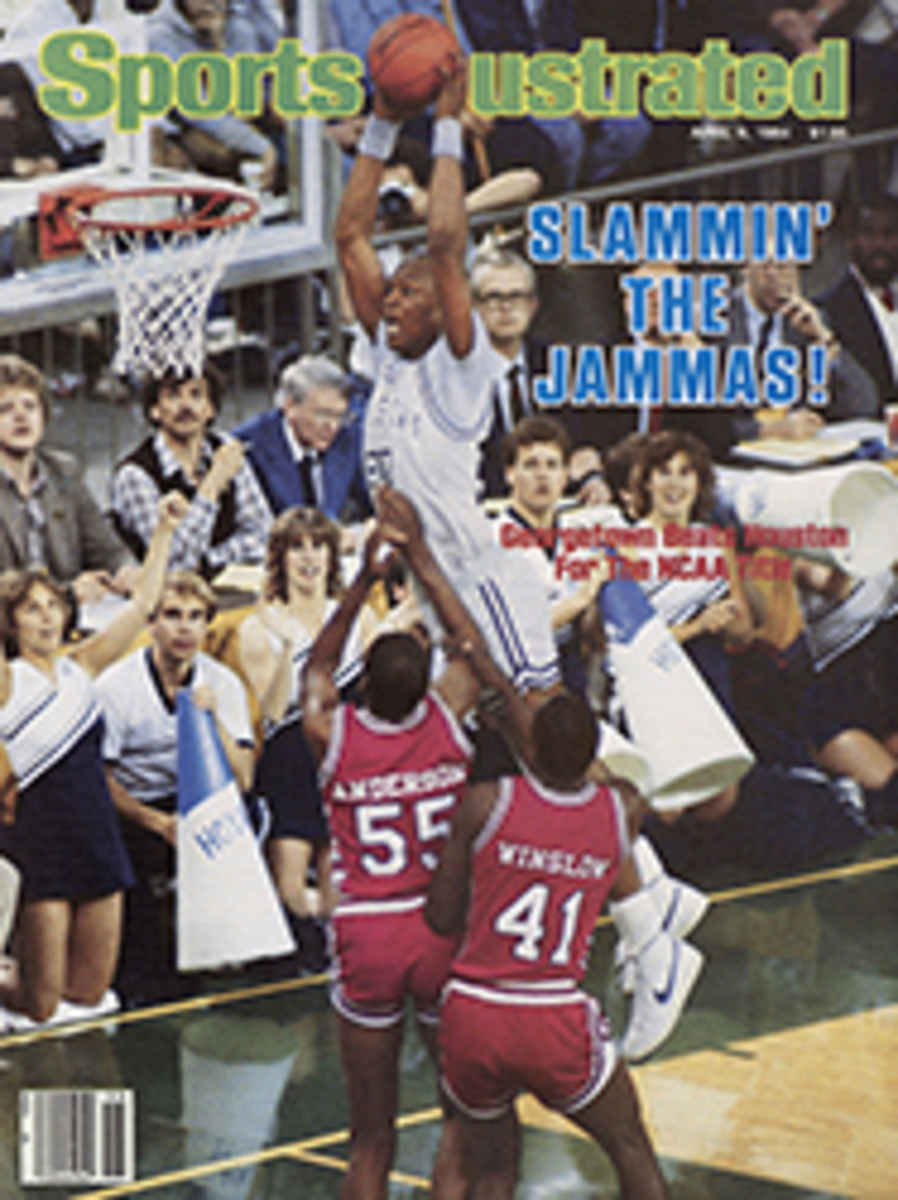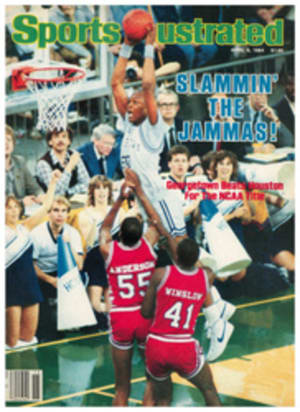
Andretti was good and ready
When Mario Andretti's bright-red Lola appeared on Seaside Way on Sunday, leading the field of the Long Beach Grand Prix by about 50 yards after half a lap, the roar from the crowd echoed in the canyon-like street until it was obliterated by the shriek of his engine. For the next 111 laps of the 187.04-mile race the 27 cars that were chasing him only fell farther and farther behind. But Andretti didn't win the race so much as he may have saved it for the fans. Mario, our all-American Italian immigrant, the three-time Indy car points champion, winner of the 1969 Indianapolis 500 and 1978 world driving champion, was singlehandedly holding off an invasion of foreign drivers. Like the little all-Italian Teo Fabi, who stormed the CART circuit last year from a nowhere season in Formula I to take the pole at Indy and win four races plus rookie-of-the year honors, they had come seeking America's greener pastures. For two days of practice and qualifying the Formula I rejects had been embarrassing CART's best.
The Grand Prix was almost a whole new event. After eight artistically successful but financially so-so years of being a Formula I race, Long Beach refused to cough up the multimillion-dollar front money demanded by the mostly European F/I series and switched to Indy cars. The promoters figured it wouldn't make a lot of difference—the cars looked pretty much the same to the spectators, especially at 180 mph, and besides, the fans would be able to pronounce the drivers' names now. But, because of Fabi's achievements, nine funny-talking Indy car drivers had signed up for this season. European drivers had taken to these cars before, two decades ago, when the likes of Jimmy Clark and Graham Hill electrified Indianapolis. But to be burned by such Grand Prix backmarkers as Roberto Guerrero and Bruno Giacomelli?
A spate of brutal infighting has died down in racing, both here and in Europe, but now a battle for prestige has begun between the two circuits. CART has the edge for the moment. As it booms—its purses will amount to $10 million this year—F/I is struggling against a growing overhead. Said Derek Daly of Ireland, who's in his second CART year after finishing the 1982 F/I season in 13th place, "A lot of Formula I drivers now see CART as a major, major series. Instead of sitting over there with uncompetitive rides, they're going to be coming here. The drivers are good for the series, and the series is good for the drivers."
Three minutes before the end of qualifying last Saturday, Daly, in a March, was the fastest man at Long Beach. Then Andretti wheeled his Lola out of the pits and "reached and squeezed"—deep into himself and hard on the car, respectively. Andretti thereupon bumped Daly off the pole with a time of 1:06.2 around the 1.67-mile, 11-turn street circuit, an average of 90.7 mph. In the race, he ran away from the competition so handily that at one point he was just yards away from being two laps up on the field. "It was one of those days you dream about," he said. In the past few years Andretti has been doing more dreaming about such days than living them.
This was the first race of the CART season, and there were new cars galore, many of them untried even on the test track. There was a gleaming Eagle from Dan Gurney's All American Racers, and Gurney might have taken the words out of a few other team managers' mouths when he said, "We came here with one car, one engine, and one afternoon of practice." Everybody's bugs, including the organizer's, seemed to bite on Friday and Saturday. At the end of Friday's practice sessions, Guerrero, a 25-year-old Colombian educated in England and now living a few miles south of Long Beach in San Juan Capistrano, was fastest, with Giacomelli—in Europe they called him Jack O'Malley, the Italian Irishman—next. Mind you, neither driver had made any kind of a mark in Formula I. Guerrero's best in 24 races had been a seventh-place finish, Giacomelli's a third in 69 races. But here they were, taking their first crack at Indy cars and blowing off American champions like Al Unser and Rick Mears. Saturday was a different story, however, after Andretti got his new Lola dialed in. Still, eight of the nine foreigners were among the top 12 qualifiers.
It was no secret that the race, 1,232 sharp turns long, would be a killer. Brakes and gearboxes would be especially abused, not to mention brains and bodies. "Survival of the fittest," said Andretti. Said Roger Penske, CART's most successful owner, "It's going to be a very long day." He didn't realize how painfully prophetic the remark would be. His two cars, driven by Unser and Mears, would both run slow and die young.
It was a glorious California day, breezy and cloudless, as the cars took the green flag on Shoreline Drive and accelerated up to 180 mph before braking down to 40 and squeezing into the first turn. The way Andretti split, it seemed he was either out to prove something or the new Lola was beyond sensational. Daly held second for a while—he faded steadily to finish seventh—but was passed by Fabi in his March, who then made a vain effort to catch Andretti. That charge ended on the 51st lap when Fabi's Cosworth engine stalled. After Al Unser Jr.—Little Al, with a foot as red-hot as his hair—retired with engine failure, suddenly in second was young Michael Chandler in the Eagle, powered by a stock-block Pontiac engine, one of only three cars in the field not using the $46,000 turbo-charged Cosworth power plant.
A hometown Cinderella finish was brewing. Chandler, son of Los Angeles Times publisher Otis Chandler, has shown some very promising stuff but has yet to break through. Gurney, from nearby Newport Beach, whose Eagles dominated Indy car racing in the mid-'70s, needs a winning chassis again. Never mind that Andretti had lapped Chandler; the Eagle was in second. And as Chandler poured it on, the stock-block engine sounding like thunder as its notes bounced off the buildings bordering the course, Gurney must have been jumping the way he does in his Toyota commercials. Chandler's gearbox went south on Lap 58, but at least he and Gurney had made a brave beginning.
Second place was inherited by Geoff Brabham of Australia, an often underrated and sometimes overlooked son of three-time world champion Jack Brabham. Geoff was driving for all he was worth in the corners—and it showed—because the engine in his March was running on only seven cylinders, costing him time on the straights. Yet another racing offspring, Andretti's own son Michael—who had qualified seventh, just ahead of Brabham—was plagued by a multitude of engine problems and struggled all day to finish 10th.
Meanwhile, attrition ate away some more of the field, and then, there in third was 1983 Indy 500 winner Tom Sneva, who isn't known for his road-racing prowess. "He'll learn," his crew chief had said earlier in the week, and Sneva bore him out. They finished like that, with Brabham running out of fuel on the last lap, 63.2 seconds behind Andretti. Sneva strolled happily into Victory Circle, rolling his eyes at a friend as if to say, "I'm not sure I believe it, either."
Andretti's victory (2:15.23, 82.8-mph average) tied him with Al Unser for second place on the alltime Indy car win list, with 37 apiece to the absent A.J. Foyt's 67. And as for the question of Formula I racing vs. Indy cars, the spectators enjoyed the race, period. Andretti did, too. "The car was perfect," he said. "It ran as well as any Formula I car I've ever driven here." At 44, Andretti proved on this street course that he might well be on the way to another championship.
TWO PHOTOS
Andretti won the pole and kept his Lola far out in the lead for his 37th Indy car win.

